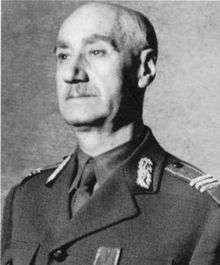Nicolae Rădescu
| Nicolae Rădescu | |
|---|---|
 | |
| Chief of the Romanian General Staff | |
|
In office 15 October 1944 – 6 December 1944 | |
| Monarch | Michael |
| Preceded by | Gheorghe Mihail |
| Succeeded by | Constantin Sănătescu |
| Prime Minister of Romania | |
|
In office 7 December 1944 – 1 March 1945 | |
| Monarch | Michael |
| Preceded by | Constantin Sănătescu |
| Succeeded by | Petru Groza |
| Personal details | |
| Born |
30 March 1874 Călimănești, Romania |
| Died |
16 May 1953 (aged 79) New York City, New York |
| Nationality | Romanian |
| Spouse(s) | Gizela Ettinger[1] |
| Profession | Military |
| Military service | |
| Service/branch | Romanian Land Forces |
| Rank | General de Corp de Armată (Lieutenant General) |
Nicolae Rădescu (Romanian pronunciation: [nikoˈla.e rəˈdesku]; 30 March 1874, Călimănești – 16 May 1953, New York City) was a Romanian army officer and political figure. He was the last pre-communist rule Prime Minister of Romania, serving from 7 December 1944 to 1 March 1945.
Before World War II, he was the leader of a far right party called Cruciada Românismului ("The Crusade of Romanianism"), the splinter group of the Iron Guard created by Mihai Stelescu.
In 1942, during Ion Antonescu's dictatorship, Rădescu wrote an article critical of the German ambassador Manfred Freiherr von Killinger and his constant intrusion in the internal affairs of Romania. He was interned as a political prisoner in the Târgu Jiu camp. On 23 August 1944, immediately after Antonescu's downfall, Rădescu was released from prison and appointed Chief of the General Staff of the Romanian Army.
He became prime minister on 7 December 1944. In this position he tried to adopt strong anti-Communist policies modelled on those of the George Papandreou Greek government. At the end of February 1945, the Communist Party of Romania and its allies organised a mass rally in front of the Royal Palace to call for his resignation. As the protest carried on, unknown persons opened fire from the Interior Ministry building situated across the street, killing some ten persons. Held responsible for this by the Soviets and the Romanian Communists, Rădescu was forced to resign. Joseph Stalin had Andrey Vyshinsky communicated the warning that the Soviet Union would not allow Northern Transylvania to be awarded back to Romania if Rădescu were to remain prime minister. He resigned his position on 1 March.
On 6 March 1945, the first Communist-dominated government of Romania took office under the direction of Petru Groza. Over the next few years, the Communists would completely consolidate their power.
In 1945, pursued by the Communist authorities, Rădescu sought refuge in the British legation, stayed there for about two months, and was then handed over to Romanian authorities, who had guaranteed his safety but placed him under house arrest.[1] In June 1946, he managed to flee on board a plane to the British Crown colony of Cyprus, where he was detained by the authorities until the Paris Peace Treaties were signed.[1] Via Lisbon and Paris he ended up in the United States.[1] Once in America, he and other exiled Romanian political figures, including Augustin Popa, Mihail Fărcășanu, Grigore Gafencu, and Constantin Vișoianu, came together to form a united anti-communist opposition in exile called Romanian National Committee. In 1950, after disagreements within the Committee, he is one of the founders of the Liga Românilor Liberi ("The League of Free Romanians"), together with Grigore Gafencu, Nicolae Caranfil, Mihail Fărcășanu, Carol "Citta" Davila, Viorel V. Tilea, general Ion Gheorghe and Vintilă Brătianu.[2]
Rădescu died in 1953 in New York City. At the initiative of Prime Minister Mugur Isărescu, the remains of General Rădescu were brought back to Romania in 2000. Following the wishes expressed in his testament, he was reburied in the Orthodox Bellu Cemetery in Bucharest on 23 November 2000.
References
- 1 2 3 4 Demetriade, Oana (October 29, 2013). "Fiul împotriva tatălui. Securistul Nicu Rădescu vs. primul ministrul Nicolae Rădescu" (in Romanian). Revista 22. Retrieved July 18, 2014.
- ↑ Kadar Lynn, Katalin, ed. (2013). The Inauguration of “Organized Political Warfare”: The Cold War. Saint Helena, CA: Helena History Press, LLC. p. 151pp. ISBN 978-0-9859433-0-1. Retrieved July 18, 2014.
